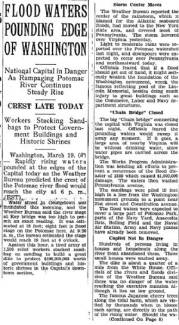Collection Name
About
FLOOD WATERS POUNDING EDGE OF WASHINGTON
National Capital in Danger As Rampaging Potomac River Continues Steady Rise
CREST LATE TODAY
Workers Stacking Sandbags to Protect Government Buildings and Historic Shrines
Washington, March 19. — Rapidly rising waters pounded at the edges of the Capital today as the Weather Bureau predicted the crest of the Potomac river flood would reach the city at 6 p. m. (EST).
Water street, in Georgetown was inundated this morning, and the Weather Bureau said the river stage at Key bridge was too high to permit an exact reading. It was estimated at 16 feet; eight feet is flood stage on the Potomac here. At 9:30 a. m., the bureau estimated the stage would reach 19 feet at 6 o'clock.
Against this hour, a tired army of 1,500 relief workers stacked sandbag on sandbag to build a great dike to protect $100,000,000 worth of government buildings and historic shrines in the Capital's downtown section.
Storm Center Moves
The Weather Bureau reported the center of the rainstorm, which it blamed for the Atlantic seaboard floods, had moved to the New York state area, and covered most of Pennsylvania. The storm hovered over Virginia yesterday.
Light to moderate rains were reported over the Potomac watershed last night, and downpours were expected to occur over Pennsylvania and northeastward today.
Officials feared that if a flood should get out of hand, it might seriously weaken the foundation of the Washington monument, wreck the famous reflecting pool of the Lincoln Memorial, besides doing much injury to great buildings such as the Commerce, Labor and Navy department structures.
"Chain Bridge" Closed
The big "Chain bridge" connecting the capital with Virginia was closed last night. Officials feared the pounding waters would sweep it away any moment. If it goes, a large area of nearby Virginia will be without drinking water, since water pipes are carried across the bridge.
The Works Progress Administration was bending all efforts to prevent a recurrence of the flood disaster of 1889 which caused $1,000,000 damage. The waters then washed Pennsylvania avenue.
The sandbags were piled 19 feet high in a line from the Washington monument grounds to a point near 21st street and Constitution avenue.
The flood waters were expected to cover a large part of Potomac Park, parts of the Navy Yard, Anacostia flats, Bolling Field and the Naval Air Station. Army and Navy planes have already been removed.
Capitol Not In Danger
Hundreds of persons living in houses and houseboats along the river front abandoned them. Three small houses were washed away.
The dike is about a quarter of a mile from the White House. Officials of the rivers and floods division of the Weather Bureau said there was no danger of the water reaching the executive mansion although it lies on low ground.
The famous Japanese cherry trees along the tidal basin, which are visited by thousands when in bloom each spring, are directly in the path of the rising water. Should the wa (Continued On Page 8)
